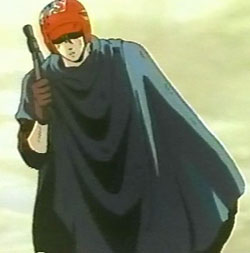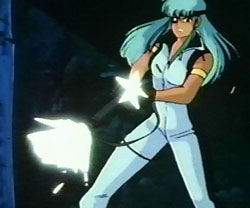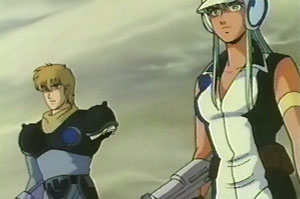Buried Treasure
Grey: Digital Target
by Justin Sevakis,
Revolutionary beliefs, ones that indicate that all existing institutions and societies are intrinsically corrupt and need to be dismantled, is something that seems mostly attached to the attitudes of adolescents and the rock music they listen to. When I was a teenager I listened to a German industrial band called KMFDM (an abbreviation for something that translated roughly to "no mercy for the masses"). They released an album called "Nihil" (as in "nihilism") and one of their favorite catch-phrases was "rip the system." And let us not forget the name of another popular 90s band, Rage Against the Machine. Today little has changed: George Orwell's book 1984 is still among the most popular audiobooks on bittorrent.
The trouble with this general adolescent anger is that it's nearly always without direction or real constructive purpose. More often it's just a reflection of general angst, and as one grows out of teen angst, so too goes the anti-establishment edge. We relax, find more people like us, and learn how to function in society to a point where we're at least mildly content. Governments and large corporations might still seem a little questionable, but realistically, living without either seems less and less pleasant with each passing year. And yet, it's hard not to sometimes wonder about our own complacency, and if the world we live in is really one that is we think it is. Every once and a while something happens to make us wonder, what if our worst fantasies about the world were true?
Anime, being an art form dominated by a poorly paid underclass, is full of such societal discontent and is thus no stranger to these ideas. Many of the OAVs and movies released in the 80s explored them through science fiction, presenting what has now become a cliché dystopian future society that its characters must somehow break free from. These shows often spend more time ripping off Western sci-fi than expressing any original ideas of their own, and most of them spend little time explaining just why this society that everyone else accepts is so terrible in the first place. I can think of few anime that genuinely says something original about the world and societies in which we live, and perhaps one of the better ones is Grey: Digital Target.

Grey: Digital Target
 As Grey: Digital Target opens, a few soldiers are looking for "survivors" of what must have been a huge catastrophe. They spot only one, a man they call Grey Death. Their reaction seems to imply that they'd have prefer there were no survivors at all.
As Grey: Digital Target opens, a few soldiers are looking for "survivors" of what must have been a huge catastrophe. They spot only one, a man they call Grey Death. Their reaction seems to imply that they'd have prefer there were no survivors at all.
This sense of foreboding badass can usually be taken as a bad portent: a surefire symptom of an 80s OAV with obvious Mad Max/Road Warrior proclivities, the likes of which usually end up in spectacular failure. To be sure, Grey: Digital Target is no masterpiece. Filled to the point of exploding with post-apocalyptic cliché and soap opera-quality dialogue, it stands little chance of being taken seriously by those with low tolerance for 80s production values. But if you approach Grey with an open mind, you might find a nihilism and a sense of desperation far beyond what pulp like this should be capable of.
 In this Orwellian distant future, towns have been divided up and given their own industries and economies but they're all ultimately ruled by the Soldiers, thugs who regularly are sent out in small groups by their local computers ("Little Mamas") into preplanned battles with each other out in the desert. Many never come back alive, but if they rise high enough in their ranks they have a chance to be come citizens of The City, a supposed paradise for the elite, it might be worth all of the sacrifice.
In this Orwellian distant future, towns have been divided up and given their own industries and economies but they're all ultimately ruled by the Soldiers, thugs who regularly are sent out in small groups by their local computers ("Little Mamas") into preplanned battles with each other out in the desert. Many never come back alive, but if they rise high enough in their ranks they have a chance to be come citizens of The City, a supposed paradise for the elite, it might be worth all of the sacrifice.
Soldier Grey's seeming invincibility comes from his single-mindedness about his goals, and his utter disregard for anything other than keeping himself alive. He makes little secret about it: he wears the helmet once occupied by his girlfriend Lips, the love of his life who attempted to become a soldier herself and died not too long after. Grey blames himself, and we see flashbacks of times when he was too weak to protect her and give her the life she dreamed of.
 Now, having lost her, Grey became a soldier himself, originally with the purpose of fulfilling her dream. He wears her helmet (despite how silly the lipstick red with big pink letters spelling out "LIPS" looks on a guy). He fights viciously, with no regard for his teammates or with orders he deems to be stupid. He survives, and in an astoundingly short period of time he's advanced to the upper ranks. He has only one friend, a guy named Red who was Lips' squad leader, and who tried to protect her. In recent years he's saved Grey's live countless times.
Now, having lost her, Grey became a soldier himself, originally with the purpose of fulfilling her dream. He wears her helmet (despite how silly the lipstick red with big pink letters spelling out "LIPS" looks on a guy). He fights viciously, with no regard for his teammates or with orders he deems to be stupid. He survives, and in an astoundingly short period of time he's advanced to the upper ranks. He has only one friend, a guy named Red who was Lips' squad leader, and who tried to protect her. In recent years he's saved Grey's live countless times.
In the first battle we see there are only two who return: Grey and a rookie woman named Nova. Nova is clearly new at this (she has a tough time leaving the body of her friend behind, even though there was no safe way to retrieve the body), and she finds the strong, silent Grey to be pretty hot. So when Grey hears that Red is in trouble, she goes with him into the war-torn areas to perform an illegal rescue.
 That's when the cracks start appearing. Financial disparities between the different towns become apparent. Some towns have tanks and heavy weaponry, and some don't even have Jeeps. And then he finds Red, who is alive and well. He's joined the resistance, trying to stop the central computer Big Mama from forcing them into hopeless and never-ending battles for no clear purpose. What's more, nobody can even be sure the fabled City even even exists -- nobody has even met a "citizen" before. But soon Grey finds that the resistance may be just as bad as Big Mama herself.
That's when the cracks start appearing. Financial disparities between the different towns become apparent. Some towns have tanks and heavy weaponry, and some don't even have Jeeps. And then he finds Red, who is alive and well. He's joined the resistance, trying to stop the central computer Big Mama from forcing them into hopeless and never-ending battles for no clear purpose. What's more, nobody can even be sure the fabled City even even exists -- nobody has even met a "citizen" before. But soon Grey finds that the resistance may be just as bad as Big Mama herself.
With nobody else to turn to and no other force with which to align himself, Grey and Nova decide to strike off on their own. As they do so, they'll find their worst suspicions to be confirmed, and say goodbye to every good person that helped them along the way. They will bring down the system, and they will fight to the bitter end.
 Perhaps Grey: Digital Target would have been better if it had only been longer. At 75 minutes it feels incredibly rushed, relying on a combination of quick flashbacks and bland dialogue to do the sort of narrative and dramatic heavy lifting that a better show would have conveyed visually. Much of the cast, deep and well written, are more or less wasted as we don't get to spend enough time with them to develop any sort of real attachment. The ending, which ends abruptly RIGHT BEFORE Grey and Nova head into their final battle with Big Mama, no doubt caused many objects to be thrown by fans. (An epilogue after the credits at least provides for SOME closure, but who knows how many fans sat that long through the thing.)
Perhaps Grey: Digital Target would have been better if it had only been longer. At 75 minutes it feels incredibly rushed, relying on a combination of quick flashbacks and bland dialogue to do the sort of narrative and dramatic heavy lifting that a better show would have conveyed visually. Much of the cast, deep and well written, are more or less wasted as we don't get to spend enough time with them to develop any sort of real attachment. The ending, which ends abruptly RIGHT BEFORE Grey and Nova head into their final battle with Big Mama, no doubt caused many objects to be thrown by fans. (An epilogue after the credits at least provides for SOME closure, but who knows how many fans sat that long through the thing.)
I lay blame for Grey's shortcomings squarely at the feet of Satoshi Dezaki, who seemed to direct and storyboard this simultaneously with They Were 11. He seems to be aware of the political undercurrents, but is more intent on delivering action scenes than using his limited running time to clarify the story any, or add meat to the characters. Nonetheless, there's still enough subtext to chew on. The idea that the resistance is itself controlled by Big Mama is thought provoking, especially in the context of the political climate of the 80s. (What does this say about the Cold War?)
 Grey also hasn't aged all that well. Its animation is fairly standard for 1986, and looks a bit simple by today's standards. I must admit that my favorite thing about Grey is the ending theme, a halting 80s exercise in J-pop cheese that can only be achieved with a "digital" themed love song. (I was singing the Engrish refrain "love is heart, human is a mystery" for days.) The English dub, produced by Ocean Group, features actors that act and a script that contains words, but they both seem to miss the point even more than Dezaki, turning the film further into a grade B action movie.
Grey also hasn't aged all that well. Its animation is fairly standard for 1986, and looks a bit simple by today's standards. I must admit that my favorite thing about Grey is the ending theme, a halting 80s exercise in J-pop cheese that can only be achieved with a "digital" themed love song. (I was singing the Engrish refrain "love is heart, human is a mystery" for days.) The English dub, produced by Ocean Group, features actors that act and a script that contains words, but they both seem to miss the point even more than Dezaki, turning the film further into a grade B action movie.
That's a lot to look past, admittedly. Grey: Digital Target simply has too many flaws to be recommended wholeheartedly. But for those that can look past its aged, dopey surface and see the political underpinnings, they might be treated to some thought provoking ideas -- ideas with roots in the revolutionary ideas of a teenager, but with the understanding of the world that only an adult can bring. It's so rare that anime takes on the problems of the world in a serious and grave manner that I absolutely must respect it, in the end.
| Obscure-O-Meter™ | |
| A | Abundant. Available anywhere that carries anime. |
| C | Common. In print, and always available online. |
| R1 | US release out of print, still in stock most places. |
| R2 | US release out of print, not easy to find. |
| R3 | Import only, but it has English on it. |
| R4 | Import only. Fansubs commonly available. |
| R5 | Import only, and out of print. Fansubs might be out there. |
| R6 | Import long out of print. No fansubs are known to exist. |
| R7 | Very rare. Limited import release or aired on TV with no video release. No fansubs known to exist. |
| R8 | Never been on the market. Almost impossible to obtain. |
| Adapted from Soviet-Awards.com. | |
Where to get it:
The 3-volume manga of Grey was an early release by Viz, and after a then-standard slow-as-hell comic book release, Viz came out with a 2-volume "Perfect Collection" version. As this predates the current manga boom, these were all expensive, unflipped paperback editions with heavy retouching. To promote the original comic books, Viz took the unusual step of selling the Japanese import VHS -- with no translations -- through their Viz Shop By Mail service.
Viz finally brought the movie out officially in 1997 on both dubbed and subtitled VHS. By that time the influx of anime titles from ADV and Pioneer had started, and Grey got lost in the shuffle. Few copies were sold, and no DVD was ever released. Today VHS copies can be found on Amazon and half.com without too much trouble, but I hold out zero hope of a re-release. I can't find any evidence of a legal DVD release in any country.
Screenshots ©1986 Yoshihisa Tagami/Tokuma Shoten • Animage Video
discuss this in the forum (21 posts) |
this article has been modified since it was originally posted; see change history